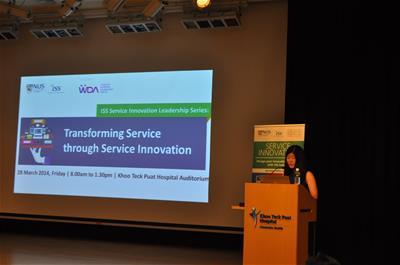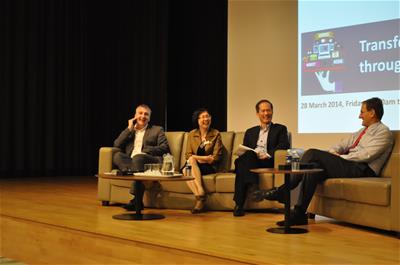Speakers at a recent ISS Service Innovation Leadership Series seminar demonstrate the transformational value of service innovation in successful organisations like Khoo Teck Puat Hospital and National Library Board.

Ms Loh Gek Khim, Director Generic Skills Development Division of Singapore Workforce Development Agency, giving the opening address
The recent ISS Service Innovation Leadership Series seminar, Transforming Service Through Service Innovation, held on 28 March 2014, demonstrated the transformation potential available to any organisation through the application of service innovation and design thinking. Principles such as reframing problems, collaborative co-creation, prototyping, and experiential user research underpinned the diverse experiences the speakers shared during the half-day event, held at the cutting-edge Khoo Teck Puat Hospital (KTPH). The speakers revealed how these service innovation techniques, and the benefits that arise from their application, are accessible to organisations of any size, and with any level of resource availability, rather than being the privilege of the few.
Mrs Chew Kwee Tiang, Chief Executive Officer of KTPH, was one of the speakers at the seminar, offering fascinating insights into the development of the hospital. The award-winning four-year-old ‘hospital without walls’ in Yishun is a beacon of inspiration in Singapore’s healthcare scene, streamlining acute health service provision to result in incredibly efficient processes and a less stressful patient experience. Their design challenge is to transform healthcare delivery. Key to meeting this challenge, Mrs Chew explained, has been an understanding of the user perspective. The leadership team walked the patient journey, from arrival through to discharge, to gain valuable insights that would inform their service improvements. Looking at the way hospital staff were working and by joining them at ground level, also revealed opportunities for improvement that simply hadn’t been obvious by studying the facts and figures alone. Mrs Chew illustrated how the introduction of simple changes has led to transformative service innovations, resulting in a better and more reliable experience for staff and patients alike.
As much as the innovation drive at KTPH is driven from the top, Mrs Chew is keen to emphasise that staff at every level have played a substantial role in the innovation journey. Numerous changes have been introduced across the hospital from staff suggestions. As a result, as well as generating effective innovations, staff feel listened to and valued, and successes are shared, creating a sustainable environment that fosters ongoing service innovation.

(left to right) Mr Stuart Smith, NUS-ISS, Mrs Chew Kwee Tiang, KTPH, Dr Christopher Chia, NUS-ISS Management Board, Prof Jochen Wirtz, Ph.D, NUS
The value of user research, and staff engagement through the service innovation process, was further evidenced by the metamorphosis of Singapore’s National Library Board, a project overseen by Dr Christopher Chia, Chairman of the ISS Management Board. The popularity of Singapore’s libraries during the 1990s, when libraries were ranked as more valuable to Singapore’s citizens than cinemas, highlighted the inefficiencies that plagued their operating systems at the time. It had not been uncommon for people to spend more than an hour queuing to borrow books. It was clear that change was required, and a fundamental review of library business processes was undertaken to identify the crux of the problems. Dr Chia explained that part of this review involved stepping into branch staff and customer’s shoes to understand exactly what was happening during the book loaning process. This user research revealed unexpected insights that would go on to inform the service innovations that transformed Singapore’s library experience to one of international best practice.
In addition to user research, prototyping is a key component of the design thinking process that was fundamental to the service innovation journeys at both KTPH and the National Library Board. Mrs Chew described KTPH as a ‘living lab’ of innovation prototyping and testing. Similarly, Dr Chia explained that service innovations introduced to existing libraries acted as prototypes for innovations that would ultimately be designed into the new flagship central library. Crucially, however, the innovations introduced within the thirteen ‘prototyping’ libraries all featured elements that were unique to their own setting. For sustainable adoption of service innovation measures, local context played a key role.
The transformation journeys undertaken by these successful, global best practice organisations demonstrate the tremendous value service innovation can bring to business, no matter its size, nature, resources or complexity. Furthermore, they remind us that service innovation is best considered as a journey rather than a destination. The innovative business is continually learning and seeking new opportunities for improvement. As Mrs Chew concluded, despite the impressive achievements at KTPH her leadership team shows no intention of resting on its laurels. Ongoing innovation is fundamental to the hospital’s future plans.
This article is first published in NUS-ISS quarterly e-newsletter, Issue 6 (Apr-Jun 2014).